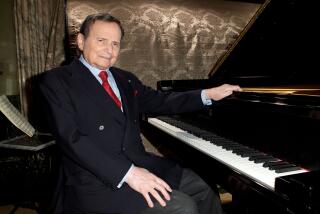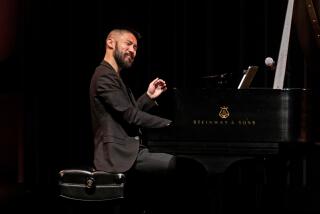Abram Chasins, Who Reshaped KUSC, Dies at 83
- Share via
Abram Chasins, a musical virtuoso whose talents ranged from performing to writing and whose professional relationships involved the greatest artists of this century, has died in his New York City apartment.
He was 83 and died Sunday. He had moved to New York from Los Angeles three years ago to complete his memoirs after being “musician in residence” at USC and reshaping the university’s radio station, KUSC, into a major noncommercial purveyor of classical music in the West.
Chasins had performed a similar feat years earlier in New York when he took a program there, “Musical Talent in Our Schools,” and broadened it into master classes broadcast over the CBS and NBC networks. In 1941 he launched classical music broadcasts over station WQXR, the New York Times radio outlet.
Judges for his school contests--in which young musicians competed against musical criteria rather than each other--included such giants as Vladimir Horowitz, Rudolf Serkin, Jascha Heifetz and a then-young Van Cliburn.
Most of those chosen for the shows never went on to professional music careers, Chasins liked to say, but their experiences made music a lasting part of their lives.
He also was exceptionally proud when the Elvis Presley Fan Club of Chicago became the Van Cliburn Fan Club in the 1950s because of those performances.
“They (the broadcasts) made the music students as glamorous as the school athletes,” he said, calling it one of his major accomplishments.
And those accomplishments were indeed major.
He was the first American composer to have his works premiered by Arturo Toscanini (“Flirtation in a Chinese Garden” and “Parade” in 1931); achieved an even earlier success with “Three Chinese Pieces” in the 1920s (a piano piece de resistance used as encore material by such keyboard giants as Josef Hofmann and Josef Lhevinne) and became a teacher of such aspiring pianists as Jorge Bolet and Constance Keene (whom he married in 1949).
Four-Handed Piano
He played four-handed piano with George Gershwin, performed for and became a biographer of Leopold Stokowski, studied with Hofmann and numbered Sergei Rachmaninoff among the admirers of his music.
His books included “The Van Cliburn Legend,” which described the young pianist’s extraordinary claiming of the International Tchaikovsky Competition in Moscow; “The Appreciation of Music,” “Music at the Crossroads” and “Leopold Stokowski: A Profile.” He wrote for Saturday Review and the New York Times Magazine in recent years and wrote of his celebrated friends in “Speaking of Pianists” in earlier ones.
Chasins was born in New York City and attended the Ethical Culture School as a child before studying at the Juilliard School. He became a protege of Hofmann, then dean of the Curtis Institute of Music in Philadelphia, who made him a member of the Curtis faculty when Chasins was only 23.
His Own Concerto
In 1929 he appeared as soloist with the Philadelphia Orchestra, playing his own “Piano Concerto,” and four years year later played his “2nd Piano Concerto” with the Philadelphia Orchestra under Stokowski.
His “Three Chinese Pieces,” which he described as “written with all the expertise of one who had never been near the Orient,” brought him acclaim from his peers, and he moved from performing to teaching--at Berkshire Center in Tanglewood at the invitation of Serge Koussevitzky. Among those listening to his lectures on Bach’s “B Minor Mass” was future composer-conductor Leonard Bernstein.
Chasins then entered his radio phase, first in New York and then in Los Angeles, before retiring. He was honored twice by the National Federation of Music Clubs for “outstanding service to American music,” in 1976 and 1951.
More to Read
The biggest entertainment stories
Get our big stories about Hollywood, film, television, music, arts, culture and more right in your inbox as soon as they publish.
You may occasionally receive promotional content from the Los Angeles Times.










